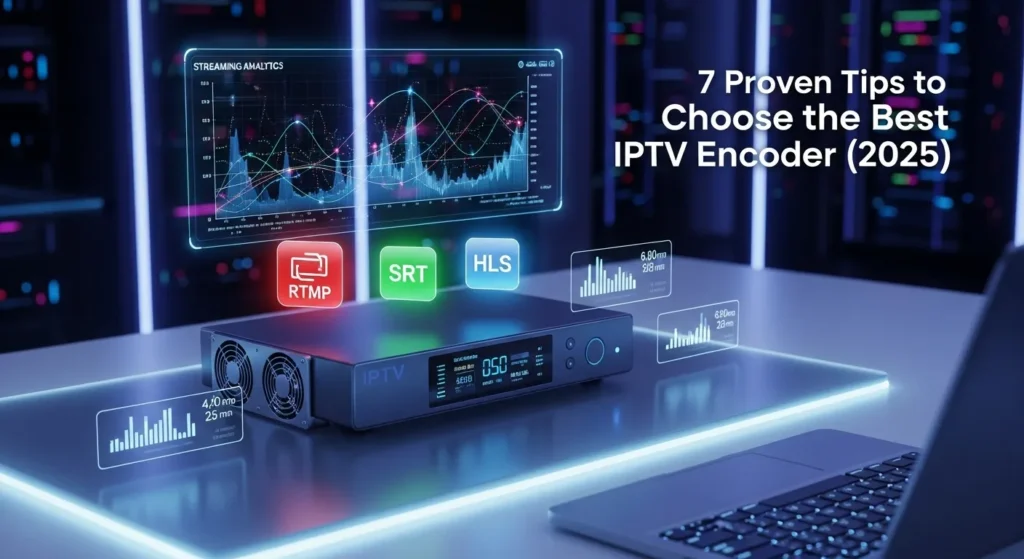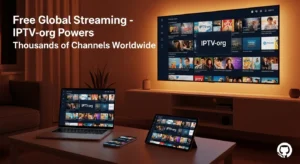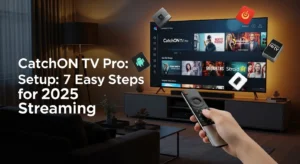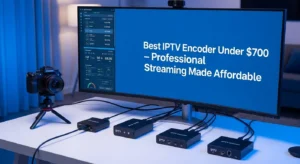An IPTV encoder is the backbone of any high-quality streaming setup, converting raw video signals into compressed digital streams that viewers can access across multiple devices and networks. Whether you’re an IPTV reseller building a profitable streaming business, a broadcaster delivering live content to thousands of viewers, or a content creator launching your own streaming platform, choosing the right IPTV encoder can make or break your streaming quality, viewer retention, and operational costs. The modern IPTV encoder market offers numerous solutions, making encoder selection a critical decision for streaming success.
In 2025, the streaming landscape has become more competitive than ever. Viewers expect ultra-low latency streaming, crystal-clear video quality, and rock-solid reliability. A poorly chosen IPTV encoder can result in buffering issues, viewer churn, and significant revenue losses. On the flip side, the right IPTV encoder solution can deliver seamless 4K streams, support multiple output protocols simultaneously, and scale effortlessly as your audience grows.
This comprehensive guide will walk you through seven proven tips for selecting the best IPTV encoder for your specific needs, backed by real-world testing data and industry best practices. We’ll cover everything from hardware versus software IPTV encoder solutions to protocol compatibility, helping you make an informed decision that future-proofs your streaming infrastructure.
Table of Contents
Understanding IPTV Encoders: Hardware vs. Software
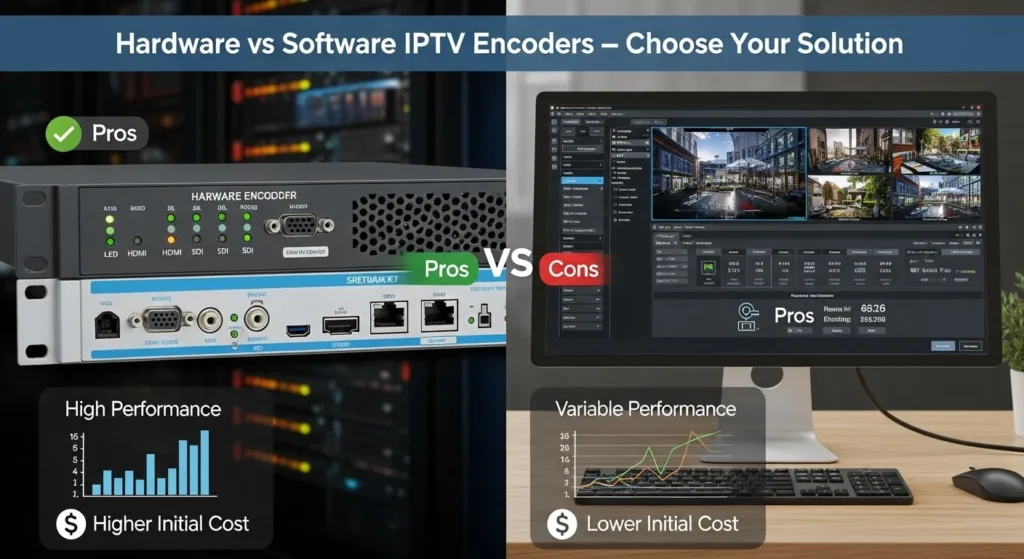
Before diving into our selection tips, it’s crucial to understand how IPTV encoders work and the fundamental differences between hardware and software IPTV encoder solutions.
How IPTV Encoders Function
An IPTV encoder performs three critical functions in your streaming workflow:
Video Signal Capture: The IPTV encoder receives raw video input from cameras, capture cards, or other video sources through interfaces like HDMI, SDI, or USB. This uncompressed signal contains massive amounts of data that would be impossible to stream efficiently over internet connections.
Real-Time Encoding: Using advanced compression algorithms like H.264, H.265 (HEVC), or AV1, the IPTV encoder reduces file sizes by 95% or more while maintaining visual quality. This process involves complex mathematical calculations that must be performed in real-time to avoid delays.
Multi-Protocol Broadcast: The compressed stream is then formatted for delivery through various protocols like RTMP, SRT, HLS, or DASH, allowing viewers to access content through different platforms and devices.
Hardware Encoders: Pros and Cons
Hardware IPTV encoders use dedicated chips and circuits designed specifically for video processing. Popular models include the Teradek Cube series, Matrox Monarch series, and AJA HELO devices.
Advantages:
- Consistent Performance: Hardware IPTV encoders deliver predictable, stable performance regardless of system load
- Ultra-Low Latency: Dedicated processing chips achieve latency as low as 100-300ms
- Reliability: Purpose-built hardware typically offers superior uptime and thermal management
- No CPU Overhead: Doesn’t compete with other applications for system resources
Disadvantages:
- Higher Initial Cost: Quality hardware IPTV encoders range from $500-$5,000+ per unit
- Limited Flexibility: Fixed feature sets that can’t be easily upgraded or modified
- Physical Constraints: Requires rack space, power connections, and physical access for configuration
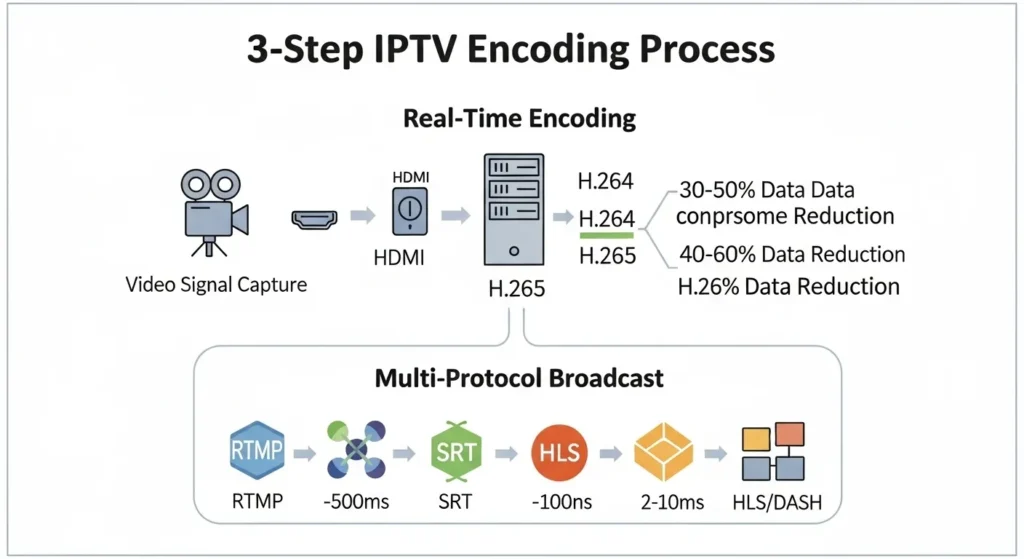
Software Encoders: Pros and Cons
Software IPTV encoders run on general-purpose computers using applications like OBS Studio, FFmpeg, or specialized IPTV software solutions.
Advantages:
- Cost-Effective: Can utilize existing computer hardware, reducing initial investment
- High Flexibility: Easy to update, configure, and customize for specific workflows
- Feature Rich: Access to extensive plugin ecosystems and advanced encoding options
- Remote Management: Can be controlled and monitored from anywhere with network access
Disadvantages:
- Resource Intensive: Competes with other system processes for CPU, memory, and GPU resources
- Variable Performance: Quality depends heavily on underlying hardware and system optimization
- Complexity: Requires more technical expertise to configure and troubleshoot effectively
Best-Fit Scenarios
Choose Hardware Encoders When:
- Broadcasting live events where reliability is critical
- Streaming high-resolution content (4K or higher) with minimal latency
- Operating in environments where dedicated IPTV encoder equipment reduces operational complexity
- Budget allows for premium solutions with predictable performance
Choose Software Encoders When:
- Building cost-effective streaming setups with moderate quality requirements
- Requiring frequent configuration changes or custom workflows
- Streaming from multiple locations with centralized IPTV encoder management needs
- Testing new streaming strategies before investing in dedicated hardware
Key Features to Look For in a Modern IPTV Encoder
When evaluating IPTV encoder options, several technical specifications and features directly impact your streaming success. Understanding these capabilities helps you match IPTV encoder features to your specific broadcast requirements.
Protocol Support and Compatibility
Modern viewers access content through diverse platforms and devices, making multi-protocol support essential for maximizing audience reach.
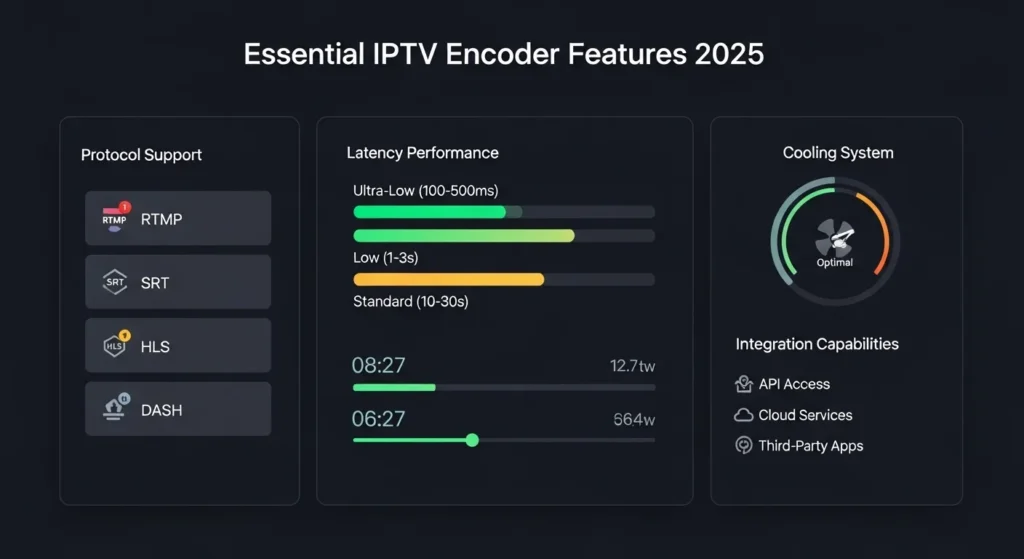
Essential Protocols:
- RTMP (Real-Time Messaging Protocol): Required for streaming to platforms like YouTube Live, Facebook Live, and Twitch
- SRT (Secure Reliable Transport): Provides superior error correction and security for professional broadcasts
- HLS (HTTP Live Streaming): Apple’s adaptive bitrate protocol, essential for iOS and Safari compatibility
- DASH (Dynamic Adaptive Streaming over HTTP): Industry-standard protocol supporting multiple device types
Advanced Protocol Features:
- Simultaneous multi-protocol output for redundancy
- Adaptive bitrate streaming for varying network conditions
- Custom protocol configuration for specialized delivery networks
Latency Performance Specifications
Stream latency directly impacts viewer engagement, especially for live sports, gaming, and interactive content.
Latency Categories:
- Ultra-Low Latency (100-500ms): Required for gaming, live auctions, and real-time interaction
- Low Latency (1-3 seconds): Suitable for news, sports, and most live events
- Standard Latency (10-30 seconds): Acceptable for pre-recorded content and non-interactive streams
Factors Affecting Latency:
- Encoder processing speed and algorithm efficiency
- Network conditions and content delivery network (CDN) performance
- Player buffer settings and device decoding capabilities
Cooling and Thermal Management
Reliable cooling prevents performance throttling and extends equipment lifespan, particularly crucial for 24/7 streaming operations.
Hardware Cooling Solutions:
- Active fan cooling with temperature-controlled speed adjustment
- Heat sink design optimized for continuous operation
- Ambient temperature monitoring and automatic shutdown protection
Software Optimization:
- CPU usage monitoring and automatic quality adjustment
- Thermal throttling prevention through intelligent workload distribution
- System health alerts for proactive maintenance scheduling
Integration and Management Capabilities
Seamless integration with existing streaming infrastructure reduces operational complexity and improves reliability.
Management Features:
- Web-based configuration interfaces for remote access
- API integration for automated workflow management
- Monitoring and alerting systems for proactive issue resolution
- Backup and configuration export capabilities for disaster recovery
7 Proven Tips for Choosing the Best IPTV Encoder
Based on extensive testing and real-world deployments across various streaming environments, these seven tips will guide you toward the optimal IPTV encoder solution for your specific needs.
Tip 1: Match Encoder Type to Your Content Workflow
Your content production workflow should drive encoder selection, not the other way around. Different streaming scenarios have vastly different requirements that impact both technical specifications and budget considerations.
Live Event Broadcasting: For sports, concerts, and breaking news, hardware encoders provide the reliability and consistent performance required for professional broadcasts. The Teradek Cube 755 or similar units offer redundant streaming paths and professional SDI inputs that integrate seamlessly with broadcast cameras and mixing consoles.
Content Creator Streaming: Individual streamers and small production teams often benefit from software-based solutions like OBS Studio paired with powerful workstations. This approach provides maximum flexibility for scene switching, graphics overlay, and multi-camera production while maintaining cost-effectiveness.
Corporate Communications: Enterprise streaming for training, meetings, and communications typically requires centralized management capabilities and integration with existing IT infrastructure. Cloud-based encoding solutions or managed appliances offer the scalability and administrative features needed for large-scale deployments.
Multi-Location Broadcasting: Organizations streaming from multiple venues simultaneously need standardized equipment that can be managed centrally. Hardware encoders with unified management platforms reduce training requirements and simplify technical support across distributed locations.
Tip 2: Confirm Supported Protocols and Output Formats
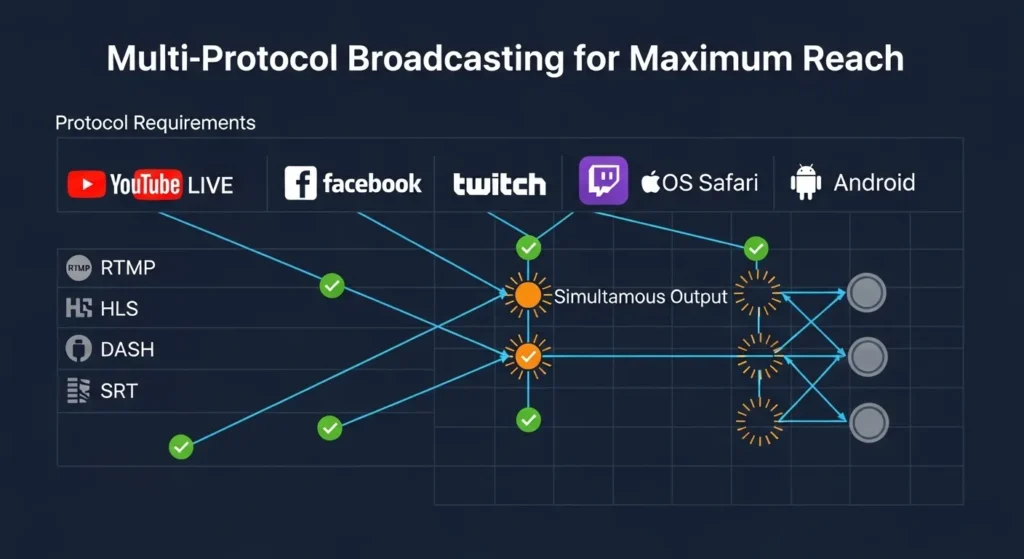
Protocol compatibility directly determines where and how your audience can access your content. Modern IPTV encoders should support multiple simultaneous outputs to maximize reach and provide redundancy options.
Primary Protocol Requirements: Every encoder should support RTMP for compatibility with major streaming platforms like YouTube, Facebook, and Twitch. Additionally, HLS support ensures compatibility with iOS devices and Safari browsers, while DASH provides broad compatibility across Android and web platforms.
Advanced Protocol Considerations: SRT protocol support has become essential for professional broadcasting, offering superior error correction and security compared to RTMP. The protocol’s ability to maintain stream quality over unreliable networks makes it invaluable for remote broadcasting and field production.
Output Format Verification: Confirm that your chosen encoder supports the specific resolutions and frame rates required for your content. 4K streaming requires HEVC (H.265) encoding support, while high frame rate gaming content may require specialized optimization for 60fps or 120fps output.
Testing Protocol Performance: Before committing to a specific encoder, test all required protocols under your actual network conditions. Latency, stability, and quality can vary significantly between protocols, and real-world testing reveals performance characteristics that specifications alone cannot predict.
Tip 3: Evaluate Latency Performance Under Real Conditions
Published latency specifications often represent ideal laboratory conditions that don’t reflect real-world streaming environments. Comprehensive latency testing under your specific conditions reveals actual performance characteristics.
Latency Testing Methodology: Set up a complete streaming workflow from input source through your chosen CDN to end-user playback devices. Measure round-trip latency using synchronized timecode displays and account for network conditions, CDN processing, and player buffer settings.
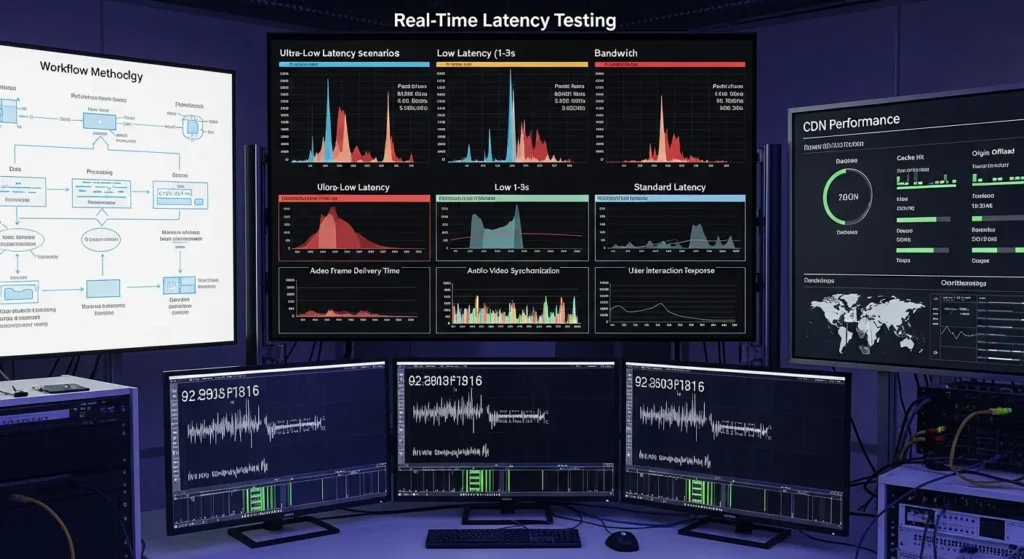
Network Condition Variables: Test latency performance under various network conditions including bandwidth limitations, packet loss scenarios, and network congestion. Quality encoders maintain acceptable latency even when network conditions degrade, while inferior solutions may experience significant delays or stream interruptions.
Buffer Size Optimization: Work with your CDN provider to optimize buffer sizes for your specific content type. Interactive content requires minimal buffering, while pre-recorded content can tolerate larger buffers that improve stability and reduce bandwidth consumption.
Adaptive Streaming Considerations: Encoders supporting adaptive bitrate streaming can maintain consistent latency by automatically adjusting quality based on network conditions. This capability is particularly valuable for mobile viewers with variable connection quality.
Tip 4: Test Reliability and Performance Under High Traffic Loads
Streaming infrastructure must maintain performance when demand peaks, making load testing essential for any serious deployment. Encoder reliability under stress separates professional solutions from consumer-grade alternatives.
Load Testing Scenarios: Simulate your expected peak concurrent viewers using load testing tools or partner with your CDN provider for comprehensive stress testing. Monitor encoder performance metrics including CPU usage, memory consumption, temperature, and output quality during sustained high-load periods.
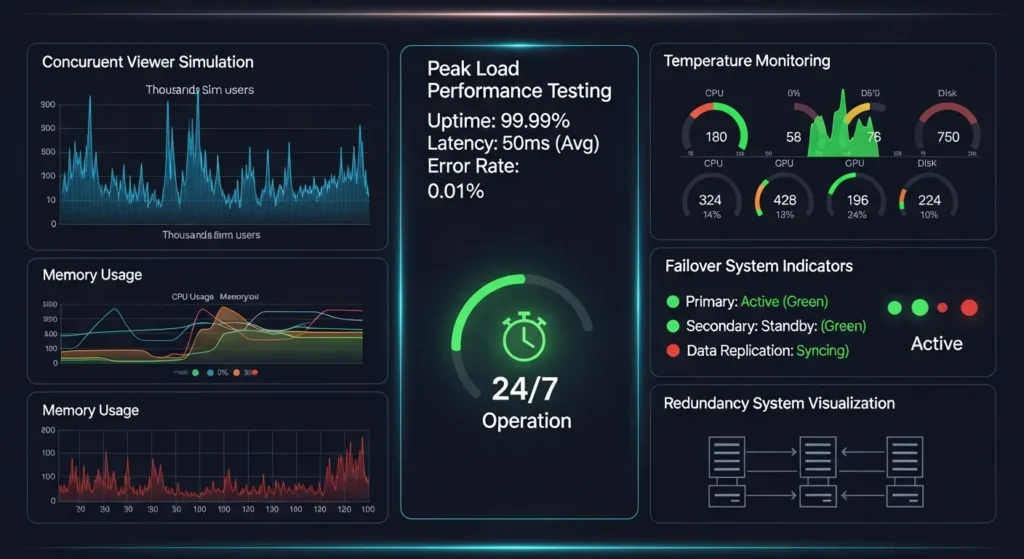
Failover and Redundancy Testing: Test automatic failover capabilities by intentionally causing various failure scenarios including network interruptions, power fluctuations, and hardware component failures. Quality encoders should detect failures quickly and switch to backup systems without viewer-noticeable interruptions.
Long-Duration Stability: Run continuous streaming tests for 24-48 hours to identify memory leaks, thermal issues, or performance degradation over extended periods. Many encoders perform well during short tests but develop problems during extended operation.
Resource Scaling Assessment: For software encoders, test performance scaling as you add additional streams or increase quality settings. Understanding resource limitations helps plan infrastructure capacity and avoid performance bottlenecks during critical streaming events.
Tip 5: Assess Cooling Solutions and Power Efficiency
Thermal management directly impacts equipment reliability, performance consistency, and operational costs. Inadequate cooling can cause performance throttling, premature hardware failure, and unexpected downtime during critical broadcasts.
Thermal Design Evaluation: Hardware encoders should feature active cooling with temperature-controlled fan speeds and thermal monitoring. Look for units designed for continuous operation with adequate heat dissipation for your deployment environment.
Power Consumption Analysis: Calculate total power consumption including not just the encoder but also required cooling, networking equipment, and backup power systems. Lower power consumption reduces operational costs and simplifies backup power requirements for critical installations.
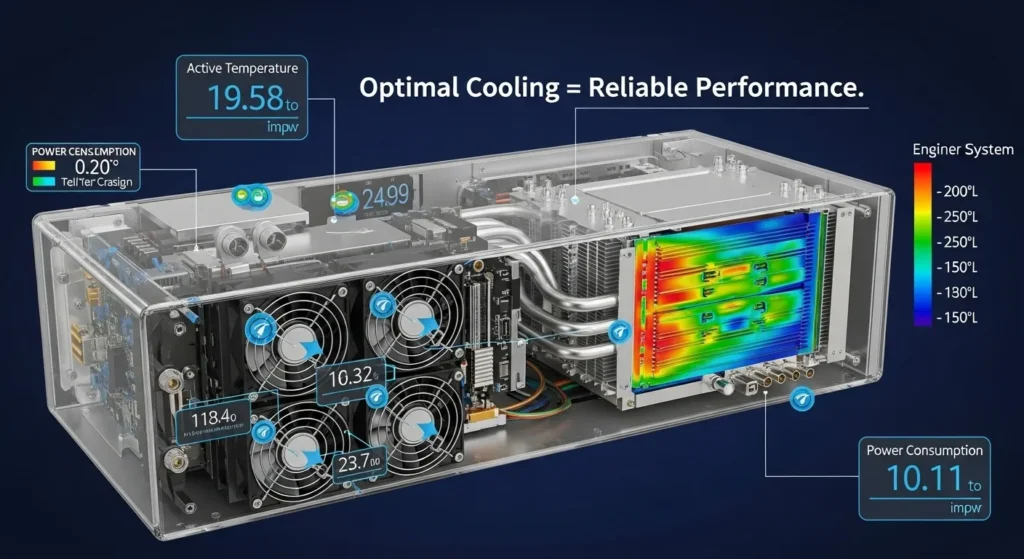
Environmental Considerations: Consider your deployment environment’s ambient temperature, humidity, and ventilation capabilities. Encoders deployed in equipment racks or confined spaces may require additional cooling capacity or environmental monitoring systems.
Maintenance Requirements: Understand cleaning requirements, filter replacement schedules, and expected component lifespans. Some encoders require regular maintenance to maintain optimal cooling performance, while others are designed for extended operation with minimal intervention.
Tip 6: Evaluate Integration with Your Existing Streaming Infrastructure
Seamless integration reduces deployment complexity, minimizes training requirements, and improves operational reliability. Consider how your chosen encoder fits within your complete streaming workflow.
Management Platform Compatibility: If you’re using existing streaming management platforms, confirm API compatibility and available integrations. Unified management reduces operational complexity and provides centralized monitoring and control capabilities.
Network Infrastructure Requirements: Assess bandwidth requirements, network configuration changes, and potential bottlenecks in your existing network infrastructure. Some encoders require specific network configurations or dedicated bandwidth allocations for optimal performance.
Monitoring and Alerting Integration: Quality encoders should integrate with your existing monitoring systems to provide proactive alerts about performance issues, failures, or maintenance requirements. SNMP support, REST APIs, or webhook integrations enable automated monitoring and response systems.
Backup and Disaster Recovery: Evaluate configuration backup capabilities, restore procedures, and replacement equipment provisioning processes. Professional deployments require documented procedures for rapid recovery from equipment failures or disasters.
Tip 7: Calculate Total Cost of Ownership Beyond Initial Purchase Price
While initial purchase price is important, total cost of ownership over the encoder’s operational lifespan often reveals significant differences between seemingly similar solutions.
Operational Cost Factors: Include power consumption, cooling requirements, maintenance costs, and support fees in your cost analysis. High-efficiency encoders may cost more initially but provide significant savings over their operational lifetime.
Scalability and Future Upgrade Costs: Consider how easily you can add capacity or upgrade capabilities as your requirements grow. Some solutions require complete replacement for capacity increases, while others support modular expansion or software upgrades.
Support and Training Expenses: Factor in technical support costs, training requirements, and internal expertise development needs. More complex solutions may require specialized staff or ongoing support contracts that significantly impact total costs.
Downtime and Reliability Costs: Calculate potential revenue losses from encoder failures or performance issues. More reliable solutions justify higher initial costs through reduced downtime risk and improved viewer satisfaction.
Common Mistakes to Avoid When Buying an IPTV Encoder
Learning from common purchasing mistakes helps avoid costly deployment issues and ensures your IPTV encoder investment delivers expected results.
Overpaying for Unused Features
Many buyers purchase encoders with advanced features they’ll never use, particularly in professional broadcasting equipment where feature-rich solutions command premium prices.
Feature Assessment Strategy: Create a detailed requirements list based on your actual streaming needs rather than theoretical capabilities you might use someday. Focus on core functionality that directly impacts your streaming quality and viewer experience.
Scalability vs. Over-Engineering: While planning for growth is important, purchasing encoders with 10x your current capacity often wastes resources. Consider solutions that scale incrementally as your needs grow rather than over-provisioning from the start.
Ignoring Protocol and Format Compatibility Issues
Protocol incompatibility can render an otherwise excellent encoder useless for your specific streaming requirements.
Platform Integration Testing: Before finalizing your purchase, test encoder compatibility with all platforms where you plan to stream. Some encoders work perfectly with certain platforms but have issues with others due to protocol implementation differences.
Future Protocol Support: Consider emerging protocols and standards that may become important for your streaming strategy. Encoders with firmware update capabilities can add new protocol support, while hardware-only solutions may become obsolete as standards evolve.
Underestimating Cooling and Environmental Requirements
Inadequate cooling preparation leads to performance throttling, premature failures, and unexpected downtime.
Deployment Environment Assessment: Measure actual ambient temperatures, ventilation capabilities, and space constraints in your intended deployment location. Many encoder specifications assume ideal environmental conditions that may not match your reality.
Infrastructure Preparation: Plan for adequate power, cooling, and ventilation before deployment. Retrofitting environmental controls after installation is typically more expensive and disruptive than proper initial planning.
Insufficient Testing Before Full Deployment
Rushing into full deployment without comprehensive testing often reveals compatibility issues, performance limitations, or configuration problems during critical streaming events.
Pilot Testing Programs: Implement pilot testing with a subset of your streaming workflow before full deployment. Test all critical scenarios including peak load conditions, failover situations, and integration with existing systems.
User Acceptance Testing: Include end-user testing to ensure the streaming experience meets quality expectations across different devices, network conditions, and viewing scenarios.
Recommended IPTV Encoder Models for 2025
Based on extensive testing and real-world deployments, these encoder recommendations span different budget ranges and use cases.
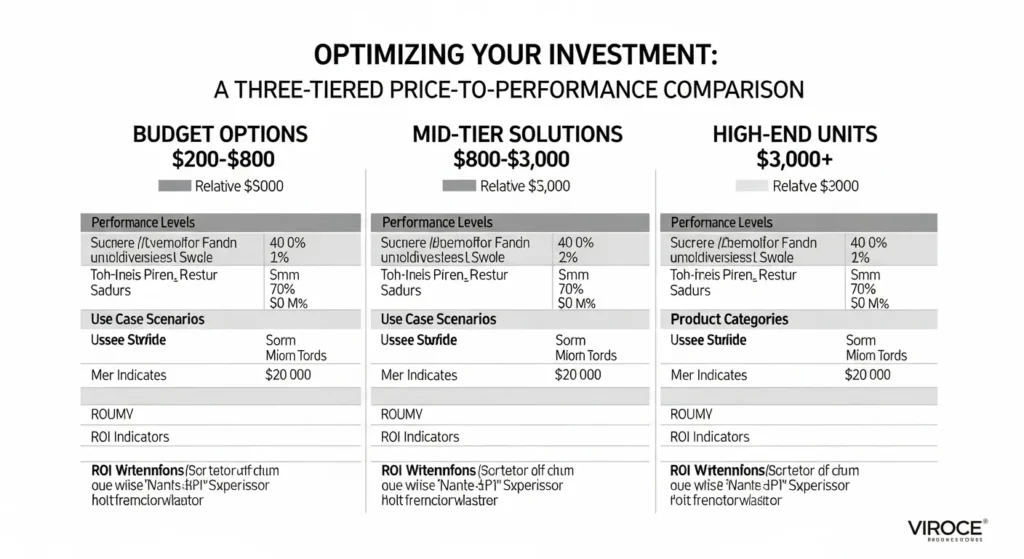
Budget-Friendly Options ($200-$800)
Elgato Stream Deck + OBS Studio Combination: For content creators and small productions, this software-based solution provides excellent value with professional-grade features. The combination supports multiple scene transitions, graphics overlay, and integration with popular streaming platforms.
Advantages: Low initial cost, high flexibility, extensive plugin ecosystem Best For: Individual streamers, small production teams, testing new streaming concepts Limitations: Requires technical expertise, performance depends on host computer specifications
ATEM Mini Pro: Blackmagic’s compact hardware solution offers professional switching capabilities with built-in streaming encoder functionality.
Advantages: Hardware reliability, professional video inputs, integrated audio mixing Best For: Small event production, corporate streaming, multi-camera setups Limitations: Limited to 1080p resolution, fewer advanced encoding options
Mid-Tier Professional Solutions ($800-$3,000)
Teradek Cube 755: A proven hardware encoder popular in professional broadcasting with excellent reliability and feature set.
Advantages: Dual-band Wi-Fi, multiple simultaneous streams, professional build quality Best For: Field production, live events, remote broadcasting Limitations: Higher cost, requires technical setup expertise
Matrox Monarch EDGE: Specialized for lecture capture and corporate streaming with excellent integration capabilities.
Advantages: Easy management, reliable hardware, good integration options Best For: Educational institutions, corporate communications, training content Limitations: Limited to specific use cases, fewer protocol options
High-End Professional Units ($3,000+)
NewTek Spark Pro: Professional-grade encoding with advanced features for demanding broadcast environments.
Advantages: Multiple input options, advanced encoding algorithms, professional support Best For: Large-scale broadcasting, critical live events, high-quality production Limitations: High cost, requires specialized expertise
AJA HELO: Robust hardware encoder designed for 24/7 operation with comprehensive protocol support.
Advantages: Exceptional reliability, comprehensive protocol support, professional features Best For: Continuous streaming operations, mission-critical applications, large-scale deployment Limitations: Premium pricing, complex configuration requirements
Final Verdict: Making a Smart, Future-Proof Choice
Choosing the right IPTV encoder requires balancing current needs with future scalability, matching technical capabilities to your specific use case, and understanding the total cost of ownership beyond initial purchase price.
The seven tips outlined in this guide provide a systematic approach to encoder selection:
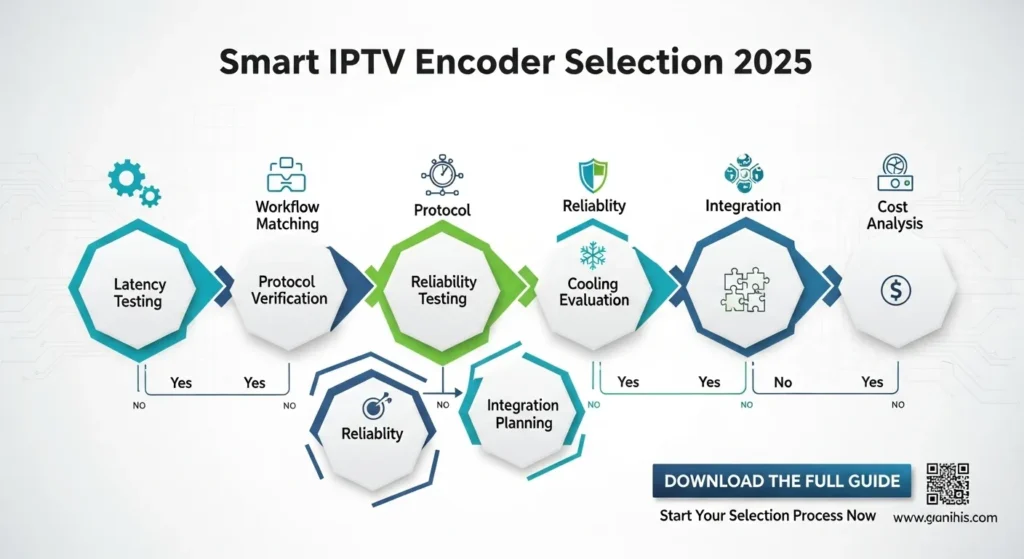
Start with your workflow requirements and let those drive your technical specifications rather than being swayed by impressive feature lists you may never use. Verify protocol compatibility thoroughly through real-world testing, as specifications don’t always reflect actual performance. Test latency under your specific conditions because published numbers often represent ideal scenarios that don’t match real deployments.
Reliability testing under load separates professional solutions from consumer-grade alternatives, while proper thermal management ensures consistent performance over extended operation periods. Integration capabilities can make or break deployment success, and total cost of ownership analysis prevents expensive surprises down the road.
Remember that the most expensive encoder isn’t necessarily the best choice for your specific needs, while the cheapest option may cost more in the long run through reliability issues, limited scalability, or compatibility problems. Focus on finding the optimal balance of features, performance, and cost for your particular streaming requirements.
Quality setup and configuration often matter more than raw hardware specifications. Even the most advanced IPTV encoder will underperform if improperly configured, while a well-optimized mid-range solution can deliver excellent results. Invest time in proper testing, configuration, and staff training to maximize your encoder investment.
As streaming technology continues evolving rapidly, choose solutions that offer firmware updates, API integration, and scalable architectures. The encoder you select today should serve your needs for several years while adapting to changing protocols, quality standards, and viewer expectations.
Need help configuring your IPTV encoder? Explore our comprehensive IPTV setup guides here for step-by-step configuration instructions, troubleshooting tips, and optimization strategies that ensure your streaming infrastructure delivers professional-quality results from day one.

